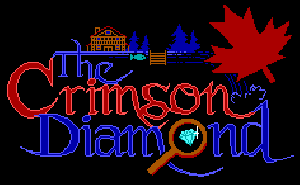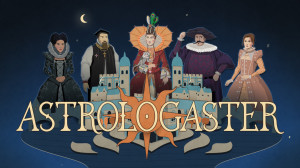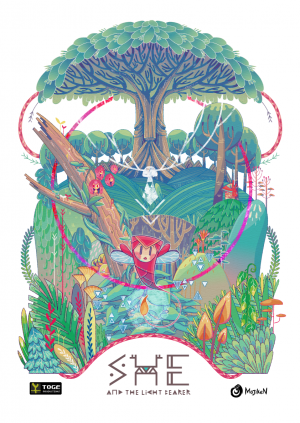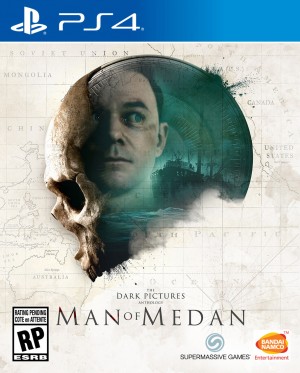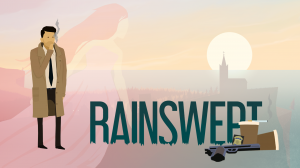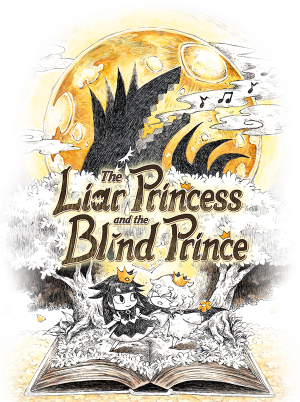AdventureX 2019 round-up: Part 2

As ever, AdventureX 2019 was a delightful place to frequent for a few rain-sodden days in London, not only for its setting in the comforting confines of the British Library but also for how welcome everyone from organisers to developers made me feel. The huge array of offerings on display, whether from first-time teams working round the clock on their passion projects to more established developers expanding their repertoires, made the event the go-to destination for any adventure game enthusiast worth their salt.
Picking up from where my colleague Steve left off in the first half of our two-part coverage, prepare for a whole new wave of furry detectives, creepy mansions and sad little imps as we venture deep into the depths AdventureX 2019 once again for the last but certainly not least round-up of the many promising games available to play during a memorable, fun-filled weekend.
Tangle Tower
 |
Detective Grimoire and Sally Spears
|
In Tangle Tower, a sequel (in terms of recurring characters if not plot) to SFB Games’ 2014 murder mystery Detective Grimoire, you once again play the quiffed private eye with a penchant for snappy one-liners as he tries to solve a murder at the eccentric titular mansion. Alongside the equally pun-happy Sally Spears, returning from the first game, Grimoire must investigate what happened to the murdered manor owner Freya Fellow, with the only “suspect” being a painting holding a bloodied knife.
With updated animations and digitally painted environments, this game looks even better than the already lauded original. There’s plenty of witty dialogue voiced up to enjoy too. A particular favourite was the exchange around a small handheld harp – the resultant lines “lyre” and “it’s the truth I swear” being just one of many jokes that made me crack a smile in my playthrough.
As with its predecessor, you have to speak to witnesses and pick up clues through simple pointing and clicking to unravel the mystery. At certain stages you’ll be invited to make new deductions by dragging specific clues down from a list to make a sentence (e.g. Freya Fellow + was killed by + the painting) which will advance the plot when all lined up correctly. This structure was a little confusing in the first example shown in the demo due to the abstract nature of the main suspect, but presumably these will become less obtuse throughout the rest of the game, which the developers told me should last up to six hours.
If you’ve been waiting a long time to get your teeth into a Detective Grimoire sequel you’re in luck, as the game is out now on Steam for Windows and Mac, as well as Apple Arcade for iOS devices and Apple TV, and the Nintendo eShop for Switch.
Aurora: The Lost Medallion
_right_thanasis_radoglou_(lead_artist)__medium.jpg) |
Giannis Chatzopoulos and Thanasis Radoglou |
The passion for adventure games could not have been more evident at this year’s AdventureX than when meeting developers Nooema Games and playing their demo of Aurora: The Lost Medallion. Director Giannis Chatzopoulos told me that he had quit his day job to make the game and regularly spends up to fifteen hours a day working on it. From playing the demo, it looks like that hard work has paid off – Aurora looks great, with a Deponia-esque cartoon quality to its graphics, but most importantly it plays great too.
You’re the titular Aurora, a young girl growing up on the frozen planet Eedor in the Trappist-1 planetary system, just a short 39 light years away from Earth. Raised by artificially intelligent robots and with no knowledge as to her origins, she and a group of children play in the underground cave systems, waiting out the hours until they must make their “Pilgrimage,” an ancient journey to the top of a hollow mountain where they can convene with the mysterious “Voices” and find out their purpose. Naturally there’s a “but” coming: Aurora was born with no such voice to guide her, and so the story follows her search for an identity in this mysterious adult-less world.
If the premise sounds complicated, that’s probably because the plan is to give the story plenty of time to breathe across four full episodes, with only the first available to sample firsthand in London. The demo showed off a traditional third-person point-and-click adventure, in which I picked up objects and combined / used them to solve puzzles.
The puzzles themselves were satisfying to solve, as I followed Aurora around her underground home whilst playing a form of hide-and-seek with the other children, challenged with not only finding the elusive kids scattered throughout the complex but also drawing them out of their hiding places. One particular puzzle required my limited knowledge of physics to work out the clever solution to a crowbar that was slightly too big to use as a lever. There were plenty of “eureka moments” like this throughout the demo featuring tasks smartly put together which all made logical sense.
Here’s hoping that the first full episode of this grand space odyssey, out on Windows, Mac and Linux in the first quarter of 2020, will keep up the pace and quality of the demo which is available now to download on Steam.
Backbone
 |
Aleksandra Korabelnikova |
You can’t escape games featuring anthropomorphic detectives at the moment, but EggNut’s Backbone has a little bit more up its tightly fitting trench coat than just its furry protagonist. Yes, you play Howard Lotor, a raccoon P.I. who’s weary of the world, but stepping into that world – a dystopian, beautifully pixelized version of Vancouver – is a noir-ish joy. The demo started with Lotor searching the rain-drenched downtown streets looking for leads on an otter who’s disappeared. Silhouettes hurried past in the foreground whilst smoking animals slumped out of grubby apartment window ledges in the background, and all around pockets of lamppost light permeated neon shades of blue and purple. Dystopia never looked so pretty.
Lotor’s first mission is to get inside a club where he thinks his missing otter has been spotted recently, and to do this you’ll have to ask around for help from some of the street’s ne’er-do-wells. Start a conversation and you’re presented with a range of dialogue options to choose from, some more aggressive than others. It’ll be interesting to see whether these choices affect the story arc or whether you’ll still be lead down the same path – when finally gaining access to the club for instance, I was promptly kicked out again for failing to gain the owner’s trust and ended up climbing up a newspaper stand to sneak in through the roof.
To do so I had to sneak my way past rodent henchmen (dressed in very snappy polo necks) by keeping to the shadows. Developer Aleksa Korabelnikova told me these stealth elements will feature throughout the game but will be kept fairly simple so that even the most ardent adventure game fan can creep through with relative ease just by pointing and clicking The issue with sneaking in 2D is it’s a little tricky to see which parts of the on-screen furniture you’re supposed to hide behind, but I eventually managed to dodge my way past the trendy thugs and further into the club. There a satisfying code-cracking puzzle awaited me, followed by a trip into the club’s dimly lit kitchen for the demo’s dark denouement.
Backbone may riff on many similar atmospheric dystopian-future offerings but its detailed animations, gorgeous pixel art and intriguing adult world is one I’m eager to revisit when the game is released on PC and consoles in the fourth quarter of 2020. For those who can’t wait that long, a lengthier version of the AdventureX prologue demo is available on Steam for Windows, Mac and Linux.
Inspector Waffles
 |
Yann from Goloso Games |
What was I saying about anthropomorphic detectives? They’re the new “breaking the fourth wall to tell a Monkey Island joke.” Goloso Games’ Inspector Waffles has a titular feline P.I. as well, along with some top notch cheesy cat puns (a painting on the wall is by “the famous Meowgritte”). It’s decidedly lighter in tone and colour palette than Backbone, but still looks very pretty in 2D pixel art, the inspector’s animated tail swishing thoughtfully in a particularly pleasing touch as he arrives at the scene of murder victim Fluffy.
Though indie solo developer Yann tells me that The Darkside Detective wasn’t an inspiration for his game, Waffles and his painfully earnest canine superior Officer Patches evoked warm memories for me of a certain Detective McQueen and Officer Dooley, as did its puns, pixels and inventory puzzles. Rather than a series of self-contained cases to complete, here there’s a single larger story to unravel. In between searching for clues amongst Fluffy’s abode – the characters remaining static on-screen while you use the mouse to pick up objects or use them – snippets of radio reports and news headlines recount the ongoing battle of two mayoral candidates fighting for election and hint at a big case in the inspector’s own past which nearly forced him into early retirement. It’ll be interesting to see how this all plays out alongside solving the present-day murder case.
Anyone eager to get their claws into Inspector Waffles will have to make do with the demo on Steam for Windows PC in advance of the full game’s 2020 release.
Crimson Diamond
 |
Julia Minamata |
Look at The Crimson Diamond. Play The Crimson Diamond. Love The Crimson Diamond. No, don’t worry; I haven’t suffered a debilitating attack of exhaustion after a full weekend of playing games. Just channeling my inner text parser à la the first video game project from Canadian artist and developer Julia Minamata. It’s an attractive looking debut effort which caught many people’s eyes across the hall during AdventureX, and for good reason – Julia has lovingly brought back the retro text-driven, 16-colour EGA palette seen in early Sierra games such as the Laura Bow mysteries which seasoned adventure gamers can’t help but get all nostalgic and gooey over.
The premise is a simple if intriguing one: as amateur geologist and put-upon detective Nancy Maple you must visit the fictional ghost town of Crimson, Ontario to investigate the discovery of a huge diamond there. The demo had me snooping about the town’s lodge using the keyboard both to move about and type in commands, interviewing a cast of peculiar characters and picking up odd objects. A nice touch is that if you get lost amongst the many possible commands at your disposal, you can take a look at your notebook for a list of the main things you need to complete (albeit at the expense of missing out on some of the fun unessential things you could discover along the way).
With its EGA stylings and text parser gameplay, it’s great to see old ways being updated for modern audiences by passionate developers. The Crimson Diamond will be shining bright on Windows PC in the first quarter of 2020, but in the meantime you can check out the demo on Steam.
:THE LONGING:
Studio Seufz’s :THE LONGING: is the antidote to our rushed, activity-packed lives: an ultra-slow idle adventure which takes 400 days in real time to complete. Well, it will do, if you load up the game and do nothing, then come back to it in 13.1507 months’ time. But there are ways of making the experience go by quicker when present, alongside simply letting it play out when you’re not there, which you’ll slowly (quite literally) discover. You play as a sad little black impish being with big Dobby-from-Harry-Potter-esque eyes called “The Shade,” the last servant of many, ordered to wait for 400 days in an underground cavern until his master the King wakes up from a very deep sleep.
 |
Volker Ritzhaupt from publisher Application Systems Heidelberg |
And so you trundle around the hand-drawn landscapes, exploring empty room after empty room by clicking where to go, talking to yourself out loud in lonely but darkly comedic monologues and occasionally picking up items like coal or maybe even a coloured piece of loam. Treasure these rare finds, because if you return them to your home cave, you’ll be able to use them to make your space a little more inviting.
Volker Ritzhaupt from publisher Application Systems Heidelberg was on hand to explain that making your home more comfortable to live in will make the clock count down quicker. In fact, he was able to complete the game in a mere ten days. As well as loam, which you can use to draw, you can even collect whole novels like Moby Dick and read them yourself, or leave the imp to read whilst you get on with other things to make the clock jump ahead even more.
For longer distances, there will be a waypoint system that allows you to mark certain key locations in your menu and set your lonely servant off to make his way there on his own, checking up on him later when he’s arrived. However, some time-specific puzzles may need you to wait to unlock further areas of the huge map, such as a gap you can’t immediately jump over because it needs a whole week to pass for a certain type of moss to grow for you to cross it. For less patient gamers, Volker told me there will be four endings to attain but thankfully only one that requires you to last the entire 400 days to see it.
It’s a much shorter wait than 400 days until this game comes out on Steam for Windows, Mac and Linux in February or March of next year.
Astrologaster
 |
Jennifer Schneidereit |
Nyamyam Games’ latest offering bears certain similarities with their 2014 release, Tengami, but also some significant differences. Astrologaster follows the story of real-world 16th century astrologist and herbalist “Doctor” Simon Forman, who read the stars to foretell how to treat his patients, with surprising success. The demo saw me playing as Simon trying to treat some of these ailing people, with the ultimate aim to win a medical licence using points added up from written recommendations from your various clients.
Simon’s world is laid out as a beautifully stylized pop-up book, with animated characters telling their woes to the astrologer in the foreground against a backdrop of the night sky behind you. Each new patient gets their own dedicated page sequence to be clicked and dragged as if pages in a book, and most cases are introduced with some merry Renaissance-era music – think flutes and lutes – and singing in rhyme, a nice touch to set the scene.
Whilst developer Jennifer Schneidereit told me that some of the patient cases are based on actual people that went to visit Forman, taken from the digital archives at Cambridge University, tongue is planted firmly in cheek when it comes to telling their stories. For example, one woman who visits Simon describes having an evening of merriment the night before and waking up with a “headache and involuntary purging.” It doesn’t take an Elizabethan astrologer to deduce that she might well be suffering from a hangover, but here you’ll then have the chance to “read the stars” to give suggestions on how she should proceed.
This basically means clicking between different zodiacs presented in the sky, each with slightly different interpretations of what might be the issue – e.g. in this scenario Saturn might suggest that our lady has been besieged by a case of black bile, so choose this option and Simon will suggest to her that she needs to simply take a day for everything to settle. There don’t seem to be any “wrong” choices but the catch is that you want your patients to recommend you, so particularly later in the game you might find yourself telling people what they want to hear, rather than what’s really going on. There will also be basic shape-based puzzles introduced as you progress to challenge you to read the stars correctly. In between, expect a lot Blackadder II-style humour, jubilant sing-a-longs and, naturally, plenty of ruffs.
Released earlier this year, Astrologaster is available for download on Steam and itch.io for Windows and Mac, as well as the App Store for iOS devices.
A Juggler’s Tale
 |
Dominik Schoen |
A Juggler’s Tale is a beautifully realised side-scrolling story told by a voiced narrator, in which you play a puppet named Abbey, dangling by marionette strings, who decides to break away from her performing way of life and her own strict narrative.
This puzzle-platformer will take roughly two hours to play in total. I was able to guide Abbey in taking the first steps to freedom by trying to escape a circus ringleader who’s held her and a gruff old bear in captivity. Your very existence as a marionette creates its own kind of puzzles – try to move across the screen when obstacles high above are in the way and your strings will get tangled. In the demo I enlisted the bear’s help to reach higher places.
There’s a traditional lyrical-style fairytale feel to the narration, which developer Dominik Schoen told me will start to create tension between puppet and master as Abbey disobeys what the all-knowing voice wants her to do. And given the faintly dark ending of the demo, it seems that despite the brightly coloured locations and characters I observed, this tale will probably end up being more Grimm than Disney.
A Juggler’s Tale will be released no strings attached on PC, hopefully by the end of 2020, and then at a later date on consoles.
Vagrus: The Riven Realms
 |
Gary Mácsai |
Lovers of spare time beware: the standalone “Pilgrims of the Wasteland” tutorial for Vagrus: The Riven Realms, which I played as a demo at AdventureX, should take roughly ten hours to complete on its own. It’s a lot of time to commit to a tutorial, even one with richly formed lore involving a post-apocalyptic-cum-Roman-Empire -themed world where you play as the eponymous Vagrus, a kind of hardened traveler who helps escort cargo and passengers from settlement to settlement between dangerous wastelands.
But Vagrus is a dense game, with many, many layers. There’s its text adventure side, which will see you shape the conversation of detailed descriptions of battles, as well as encounters with all kinds of vagabonds and monsters and occasionally quiet chats with your crew as you try to suss out whether they still trust you and whether they’re still to be trusted. Whilst sometimes that’ll just be a case of choosing between dialogue or action options, as you progress and earn more experience you’ll also gain certain perks which might unlock more choices for you to choose from.
There’s also its strategy game side, in which a tabletop view of your journey through the Mad Max-like wilderness allows you to keep your company feeling well and rested by buying enough supplies at the towns you pass along the way, as well as topping up their wages and making sure they’re healthy enough to fight for you. And speaking of fighting, there’s the game’s RPG side – battles aren’t just written down in Vagrus. Instead, at certain points you’ll be transported to a side view of a battlefield to duke it out in turn-based combat with your chosen crew members and whatever nasties stand in your way, choosing spells or melee attack or defense options to batter your opponents.
The tutorial, which developers Lost Pilgrims consider a must to complete before attempting the main game, will introduce players to the many, many options that will become available in the much less linear and more open world of The Riven Realms, whilst using the same intricate gameplay systems as I saw in the demo.
For now only backers of The Riven Realms’ Fig Open Access campaign can see if they have what it takes to become a true Vagrus by playing through the tutorial, with early access for the full game planned to be unlocked this December, followed by the public release later in Q1 2020.








